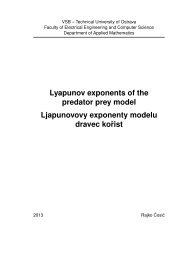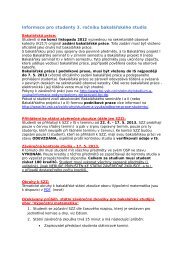The Boundary Element Method for the Helmholtz Equation ... - FEI VÅ B
The Boundary Element Method for the Helmholtz Equation ... - FEI VÅ B
The Boundary Element Method for the Helmholtz Equation ... - FEI VÅ B
Create successful ePaper yourself
Turn your PDF publications into a flip-book with our unique Google optimized e-Paper software.
22 2 <strong>Helmholtz</strong> <strong>Equation</strong><strong>the</strong> normal vector n can be expressed as (see Figure 2.2)n(x) = − 1 (x − y)εand thusHence, we have∂v κ(x, y) = 1∂n x 4π1ε1 − iκ∥x − y∥eiκ∥x−y∥ .∥x − y∥I 2 = 1 2π π24π 0 − π 21ε1 − iκεeiκε ϕ y + ε(cos ϑ cos ψ, sin ϑ cos ψ, sin ψ) ε 2 cos ψ dψ dϑε= 1 2π π2e iκε (1 − iκε)ϕ y + ε(cos ϑ cos ψ, sin ϑ cos ψ, sin ψ) cos ψ dψ dϑ.4π 0 − π 2<strong>The</strong> Lebesgue dominated convergence <strong>the</strong>orem allows us to interchange <strong>the</strong> limit and <strong>the</strong>integration. Moreover, because ϕ ∈ C ∞ 0 (R3 ) andlim e iκε (1 − iκε) = 1,ε→0 +we obtainand finallylim I 2 = 1 2π π2ϕ(y) cos ψ dψ dϑ = ϕ(y)ε→0 + 4π 0 − π 2which was to be proved.I = ⟨∆ṽ κ + κ 2 ṽ κ , ϕ⟩ = limε→0 +I 1 − limε→0 +I 2 = −ϕ(y) = ⟨−δ y , ϕ⟩,2.3 Representation Formulae<strong>The</strong> following two <strong>the</strong>orems <strong>for</strong>m <strong>the</strong> basis of <strong>the</strong> boundary element method, providing<strong>for</strong>mulae <strong>for</strong> calculating <strong>the</strong> solution to a boundary value problem in any point of <strong>the</strong>given domain. Firstly, we focus on interior problems, i.e., problems on bounded domains.<strong>The</strong>orem 2.6 (Representation Formula <strong>for</strong> Bounded Domains). Let Ω ⊂ R 3 be a boundedC 1 domain, let v κ denote <strong>the</strong> fundamental solution <strong>for</strong> <strong>the</strong> <strong>Helmholtz</strong> equation in R 3 andlet n denote <strong>the</strong> unit outward normal vector to ∂Ω. <strong>The</strong>n <strong>for</strong> u ∈ C 2 (Ω) we have <strong>the</strong>representation <strong>for</strong>mula∂uu(x) =∂Ω ∂n (y)v κ(x, y) ds y − u(y) ∂v κ(x, y) ds y∂Ω ∂n y− ∆u(y) + κ 2 u(y) v κ (x, y) dy <strong>for</strong> x ∈ Ω.Ω









